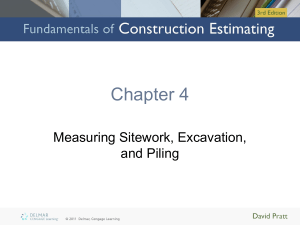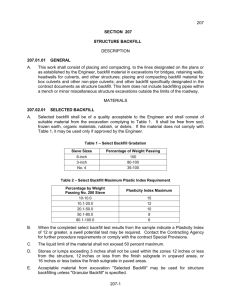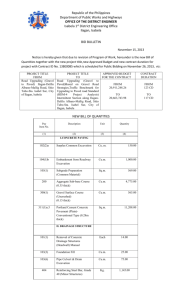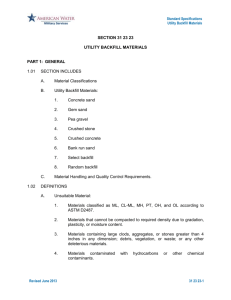Part R07 Trench Excavation and Backfill
advertisement
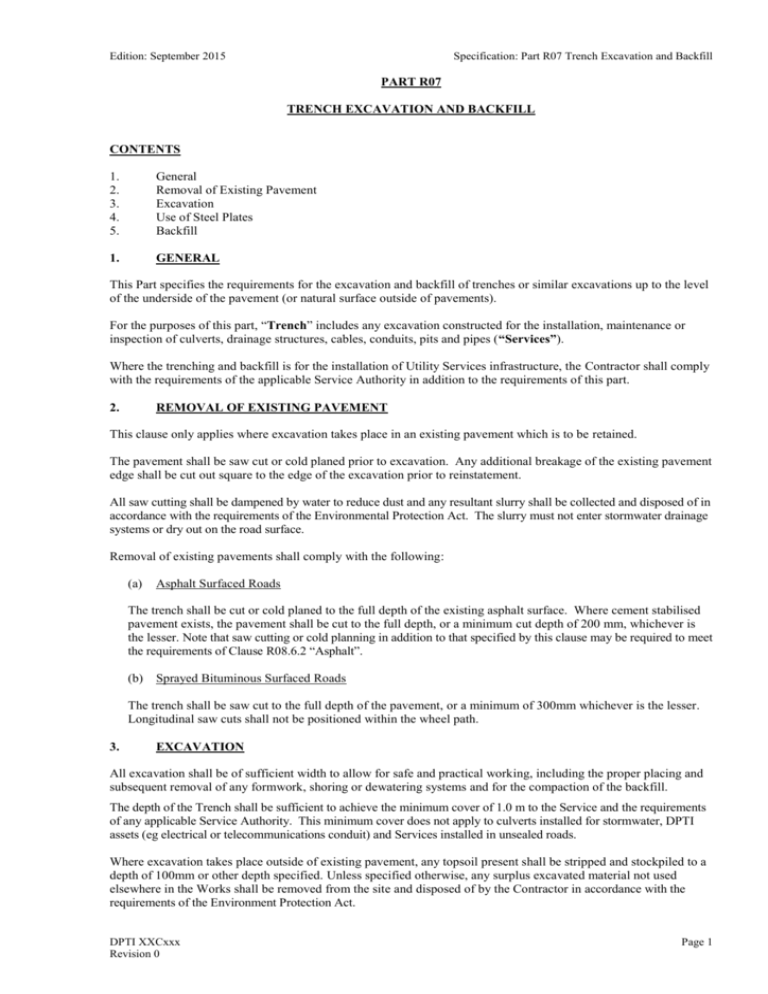
Edition: September 2015 Specification: Part R07 Trench Excavation and Backfill PART R07 TRENCH EXCAVATION AND BACKFILL CONTENTS 1. 2. 3. 4. 5. General Removal of Existing Pavement Excavation Use of Steel Plates Backfill 1. GENERAL This Part specifies the requirements for the excavation and backfill of trenches or similar excavations up to the level of the underside of the pavement (or natural surface outside of pavements). For the purposes of this part, “Trench” includes any excavation constructed for the installation, maintenance or inspection of culverts, drainage structures, cables, conduits, pits and pipes (“Services”). Where the trenching and backfill is for the installation of Utility Services infrastructure, the Contractor shall comply with the requirements of the applicable Service Authority in addition to the requirements of this part. 2. REMOVAL OF EXISTING PAVEMENT This clause only applies where excavation takes place in an existing pavement which is to be retained. The pavement shall be saw cut or cold planed prior to excavation. Any additional breakage of the existing pavement edge shall be cut out square to the edge of the excavation prior to reinstatement. All saw cutting shall be dampened by water to reduce dust and any resultant slurry shall be collected and disposed of in accordance with the requirements of the Environmental Protection Act. The slurry must not enter stormwater drainage systems or dry out on the road surface. Removal of existing pavements shall comply with the following: (a) Asphalt Surfaced Roads The trench shall be cut or cold planed to the full depth of the existing asphalt surface. Where cement stabilised pavement exists, the pavement shall be cut to the full depth, or a minimum cut depth of 200 mm, whichever is the lesser. Note that saw cutting or cold planning in addition to that specified by this clause may be required to meet the requirements of Clause R08.6.2 “Asphalt”. (b) Sprayed Bituminous Surfaced Roads The trench shall be saw cut to the full depth of the pavement, or a minimum of 300mm whichever is the lesser. Longitudinal saw cuts shall not be positioned within the wheel path. 3. EXCAVATION All excavation shall be of sufficient width to allow for safe and practical working, including the proper placing and subsequent removal of any formwork, shoring or dewatering systems and for the compaction of the backfill. The depth of the Trench shall be sufficient to achieve the minimum cover of 1.0 m to the Service and the requirements of any applicable Service Authority. This minimum cover does not apply to culverts installed for stormwater, DPTI assets (eg electrical or telecommunications conduit) and Services installed in unsealed roads. Where excavation takes place outside of existing pavement, any topsoil present shall be stripped and stockpiled to a depth of 100mm or other depth specified. Unless specified otherwise, any surplus excavated material not used elsewhere in the Works shall be removed from the site and disposed of by the Contractor in accordance with the requirements of the Environment Protection Act. DPTI XXCxxx Revision 0 Page 1 Edition: September 2015 4. Specification: Part R07 Trench Excavation and Backfill USE OF STEEL PLATES If steel plates are used to enable traffic to cross an excavation, the Contractor must ensure that: (a) the surface of the plate does not create a skidding hazard to motorists; (b) a speed restriction of 60km/h or less is imposed on the section of road where a steel plate is situated; (c) there is a smooth transition for traffic from the road surface onto the steel plate by the use of a temporary ramp; (d) the steel plate is treated with an approved anti-skid compound in accordance with the manufacturer’s instructions (the use of checker plate or plain steel alone is insufficient); and (e) the steel plate is restrained, pinned or anchored to reduce impact noises caused by motorists. The anti-skid compounds listed in the DPTI Approved Products List, available from: http://www.dpti.sa.gov.au/documents/contractsandtenders/specifications/general are approved for use on steel plates. The Contractor may submit a request for the approval of additional anti-skid products. The anti-skid compound must be maintained in good order. The skid resistance must exceed 0.5 GN when tested in accordance with DPTI Test Procedure: TP344 “Determination of Skid Resistance with the GripTester”, available from: http://www.dpti.sa.gov.au/standards/materials_technology_documents/test_procedures2 5. BACKFILL 5.1 General This clause applies to the backfill of Trenches and to the placement of backfill against Services not in excavation. Prior to, and during backfill operations, all loose rubbish and foreign material shall be removed from the Trench. All voids excavated and not occupied by permanent work shall be backfilled. Warning tape which has been specified or is a requirement of a Utility Service Authority shall be inserted at the depth specified. 5.2 Backfill Material Where Utility Services infrastructure is being installed, backfill material shall comply with the requirements of the applicable Service Authority (for SA Power Network conduits, refer to Clause 15 of SAPN Technical Standard TS-085). For other Services, backfill material shall be either Sa-C Type C Sand in accordance with Part R15 or Controlled Low-Strength Material (CLSM) in accordance with Part R09. Excavated material shall not be reused for backfill of Trenches below areas of pavement. 5.3 (a) Extent of Backfill Services Installed in Trenches Below pavement, the backfill material shall extend to the underside of the reinstated pavement. In verges and roadsides (ie outside of the pavement area), the backfill material shall extend to a level at least 300 mm above the top of the Service after compaction. Unless specified otherwise, excavated material may be used above this level. (b) Services Installed Within Fill Locations Backfill material shall be placed to a level at least 300 mm above the top of the Service after compaction. 5.4 Placement of CLSM Backfill If CLSM is used, it shall be placed in accordance with Appendix K “Controlled Low Strength Materials—CLSM” of AS 2566.2: Buried flexible pipelines - Part 2: Installation. DPTI XXCxxx Revision 0 Page 2 Edition: September 2015 5.5 Specification: Part R07 Trench Excavation and Backfill Placement of Sand Backfill Sand backfill shall be compacted alternately on each side of the Service. Backfill shall not be placed against any cast-in-place concrete within 48 hours of the placing of concrete. Flooding of sand with water is, by itself, not an acceptable method of compaction. 5.6 Backfill Against Drainage Structures Backfill placed against drainage structures shall: (a) be free draining material in locations where it is necessary to prevent the build up of hydrostatic pressures; (b) develop sufficient strength to ensure it is stable and does not undergo post construction settlement; (c) where backfill is to be placed on both sides of wing walls or retaining walls, the backfill shall be brought up level with a maximum height differential of 300 mm; (d) not be placed against concrete which is less than 48 hours old; and (e) not be placed against wingwalls or retaining walls until all cast in place concrete has reached the 28 day characteristic compressive strength and is at least 14 days old. 5.7 Compaction of Backfill Unless specified otherwise, the backfilling shall be uniformly compacted in horizontal layers not exceeding 200 mm (loose) thickness. Compaction and the compaction test frequency shall comply with Table 5.6. AS 1289, test method 5.2.1 (modified compaction) shall be used to determine the Dry Density Ratio. TABLE 5.6 COMPACTION Minimum Backfill Compaction (Dry Density Ratio - % modified) Below Sealed Pavement Below Unsealed Pavement and Shoulder Outside of areas of Pavement Between 800 mm below finished surface and the underside of pavement 95 95 90 More than 800 mm below finished surface 92 92 90 Minimum Compaction Test Frequency Small box culverts and stormwater pipes 1 m or less in diameter: 1 test per 5 m3 or part thereof Large box culverts and stormwater pipes over 1 m in diameter: 1 test per 10 m3 or part thereof All other Services: 1 test per 10 m3 or part thereof unless an approved compaction methodology has been implemented A minimum of 3 compaction tests shall be carried out. ____________ DPTI XXCxxx Revision 0 Page 3





